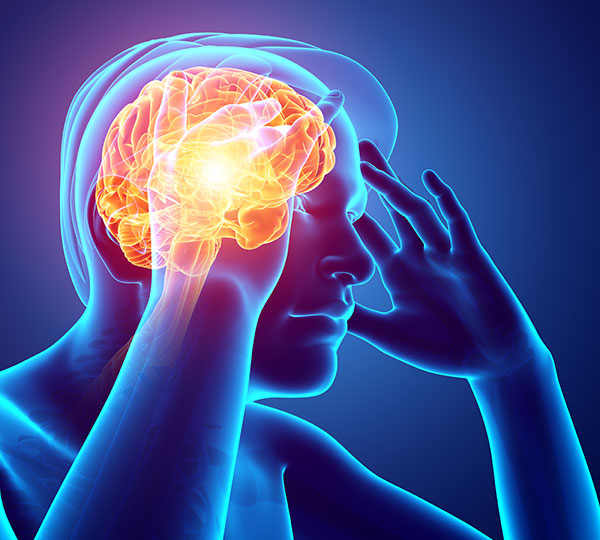Headaches
Headache Attributed to TMD
Headache related to structures in the jaw and temporomandibular region can be attributed to TMD. This type of headache usually develops with the onset of TMD, worsens with progression of other TMD symptoms, and is caused or exacerbated by specific jaw movements or when pressure is applied to the TMJ structures.
Migraine Headaches
Migraine is reported to be the third most prevalent and the seventh more disabling illness in the world. It is a common condition that affects approximately 12% of the population in Western countries. Migraine typically presents with recurrent unilateral throbbing, nausea and vomiting, of moderate to severe intensity, lasting 4 to 72 hours. Even though migraine is traditionally present above eye-ear line, it can also be present in the mid lower face. Migraine is usually associated with characteristics such as nausea, phonophobia, photophobia and is aggravated by activity. One third of patients suffering from migraine experience transient neurologic symptoms such as visual disturbance and other sensory phenomena, prior to the onset of the migraine. This phenomenon is called “aura”. Some migraine sufferers experience predictive pre-headache symptoms such as agitation, fatigue, yawning, sensory hyperactivity, increased food cravings, thirst and polyuria.
Tension-Type Headache
Tension Type-Headache is a very common source of head pain. It is described as a dull ache or non-pulsating pain of mild to moderate intensity. For many years, it was believed that this kind of headache was related to muscle tension and was referred to as “muscle contraction headache” or “muscle tension headache”. Muscle tenderness is often present with this disorder. Tension-Type Headache is often described as tightness, pressure or soreness, with a feeling of a tight head-band compressing the head. Many sufferers describe a bandlike pain distribution as if wearing a tight hat. The pain location is not specific, is often bilateral and may extend into the neck. Temporalis and masseter muscle involvement may be present, affecting mastication. Tension-Type Headache is usually not associated with nausea and vomiting, and is not aggravated by normal physical activity. Tension-Type Headache may be associated with sensitivity to light and/or noise. This type of headache usually last from 30 minutes to 7 days and occurs more often than migraine headache.
Cluster Headache
Cluster headache is described as severe, unilateral pulsating headache, lasting 15 to 180 minutes. This type of headache is accompanied by restlessness and/or agitation. The pain is present in the periorbital, supraorbital, temporal or combination of these areas. The
headache is associated with lacrimation, nasal congestion, forehead and facial sweating, forehead and facial flushing, ipsilateral conjunctival injection, sensation of fullness in the ear, miosis, ptosis, and/or eyelid edema. Cluster headache is considered one of the most severe pain conditions humans experience. Cluster attacks occur from one to eight times per day, for two weeks to two months, and often recur on an annual or biannual basis during the same season. Even though Cluster Headache has well defined characteristics.
only 21% of Cluster patients receive the correct diagnosis at the time of their initial consultation. Because of the location, severity, and abrupt onset of pain, Cluster Headache is often mistaken for Trigeminal Neuralgia. Cluster Headache may also manifest as diffuse Orofacial Pain, without the classical onset symptoms of orbital,supraorbital or temporal pain distribution.
Paroxysmal Hemicrania
This condition is a headache with clinical characteristics similar to those of Cluster Headache, but the attacks are shorter in duration (2 to 30 minutes), more frequent and predominantly occur in females. The attacks are unilateral, predominantly in the periorbital region. Paroxysmal Hemicrania is accompanied by one or more of the following signs or symptoms: unilateral lacrimation, conjunctival injection, rhinorrhea, nasal congestion, forehead/facial sweating and flushing, miosis, ptosis, and eyelid edema. Unlike Cluster Headache, restlessness and agitation are not part of the diagnostic criteria. Paroxysmal Hemicrania has a 100% positive response to the Non-Steroidal Anti-Inflammatory Drug, Indomethacin.
Henicrania Continua
Hemicrania continua is a persistent one-sided headache that fluctuates in intensity but never totally remits. Same-side autonomic features such as flushing, lacrimation, nasal congestion, corneal injection and restlessness/agitation are present in patients suffering from this headache during periods of more intense pain. This headache is considered arare headache disorder, but is often underdiagnosed.
Other Types of Headaches
- SUNCT and SUNA (Short-lasting Unilateral Neuralgiform Headache with Conjunctival Injection and Tearing)
- Headache Associated with Vascular Disorders:
- Acute Ischemic Cerebrovascular Disease
- Intracranial Hematoma
- Subarachnoid Hemorrhage
- Temporal Arteritis
- Carotid or Vertebral Artery Pain
- Venous Thrombosis
- Headache Associated with Non Vascular Intracranial Disorders:
- High Cerebrospinal Fluid Pressure
- High-Pressure Hydrocephalus Including Posttraumatic High-Pressure Hydrocephalus
- Low Cerebrospinal Fluid Pressure
- Intracranial Infection
- Intracranial Neoplasm

